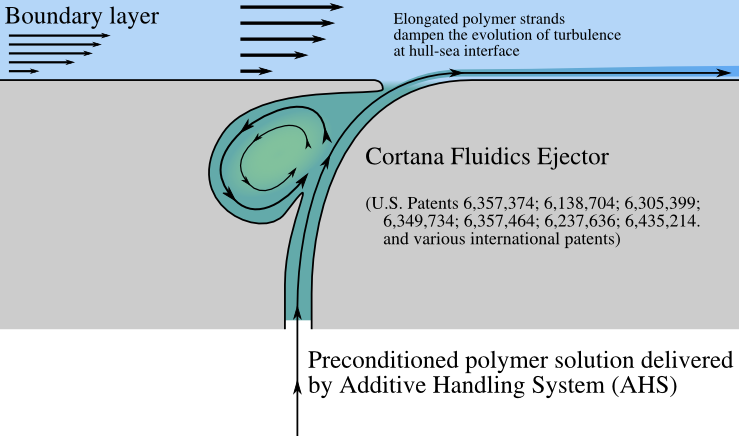Maritime Systems Optimization
Skin Friction Reduction (SFR)
Reduction in fuel expenditure rates and its associated reduction in carbon dioxide and noxious gases has always been a goal for commercial marine transportation and is now becoming a high-priority goal to many of the world's navies. The frictional drag component for traditional hull forms of displacement ships is very large. Reduction in total drag relates directly to reductions in fuel expenditure rates and atmospheric emissions. Full scale demonstrations indicate that frictional drag can be reduced by about 70% using very small quantities of polymer additives (Toms Effect). Reductions of about 50 percent in the friction component can be achieved with a self-established and maintained thin film that requires only intermittent expenditures (the Kowalski effect). These levels of friction drag reduction will permit reductions in fuel costs of 15 to 40% depending on the hull form and ship speed.
While the effect of SFR on both emission reduction and operational cost is very attractive, the effect on design may be more compelling. Naval Architects have long considered the design "Iron Triangle" to be speed-payload-endurance. That is, improving any one of those factors requires compromise with one or both of the other two. A drag reduction system can increase the speed of a ship for a given power level, or reduce the power requirement for a given speed. Thus, incorporating such a system into vessel design will reduce traditional design constraints and effectively break the "Iron Triangle" by enabling more payload and endurance options while maintaining or even increasing speed.
Additive Handling & Ejector Technology

Cortana Fluidics Ejector diagram
The potential of dilute aqueous solutions of some polymer materials to reduce skin friction reduction has been known since 1949. In 1948, a chemist from the United Kingdom, B. A. Toms, observed that mixing small quantities of long-chain molecules (polymers) into a water-based solution could reduce viscous drag of the solution in turbulent pipe (internal) flow, by up to 70 percent. Since that time, many researchers have successfully adapted this technology for commercial internal flow systems such as pipelines. However, the applications to external flow such as to seaborne vessels have been generally hindered by both the large volume of polymer that need to be ejected and the vast quantities of polymer fluid that had to be carried aboard the vessel. Until Cortana developed the fluidics ejector and the AHS (Additive Handling System), ships could only expect to use the technology for short bursts of speed, i.e., recreational racing and military vessels that might rapidly engage and retreat from the enemy. (It should be noted that Soviet, now Russian scientists and shipbuilders report the successful and relatively wide application of polymer drag reduction –PDR– on undersea vessels.) Prior to Cortana's efforts, making polymer powder down to liquid and using as-needed was not considered feasible. Reports by reputable researchers at leading U.S. Universities reported it took one to three days for the polymer powder to go into solution and reach the condition that would support skin friction reduction. (Ceccio and student)

Cortana Fluidics Ejector benifits cascade
In addition to the AHS, has developed a Cortana Fluidics Ejector, which has the unique ability relative to previous additive ejectors to eject the additive nearly tangent to the hull surface and, very importantly, not disruptive to the fluid the established boundary layer is ejected. Further, the polymer fluid undergoes "preconditioning" during which the polymer molecules are elongated so they can begin to quell turbulence immediately upon ejection. Because the Cortana Fluidics Ejector is non-disruptive this technique enables skin friction reduction immediately, i.e., it does not locally increase drag as do the traditional ejection techniques. The combination of preconditioning, which leads to immediate effectiveness upon ejection, tangential and non-disruptive ejection, significantly reduces the diffusion problem characteristic of traditional ejector technologies. Therefore, the Cortana Fluidics Ejector can eject lower concentrations of polymer at much reduced flow rates compared to traditional ejector systems and achieve higher levels of skin friction reduction. This means that coupled with the AHS (Additive Handling System) polymer ejection need not be used just for burst speed, but can now be available upon demand to reduce fuel consumption maintain or higher speed for the same installed power.